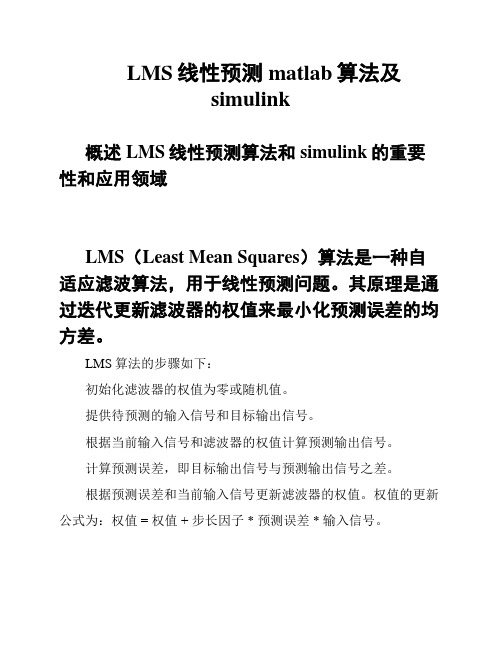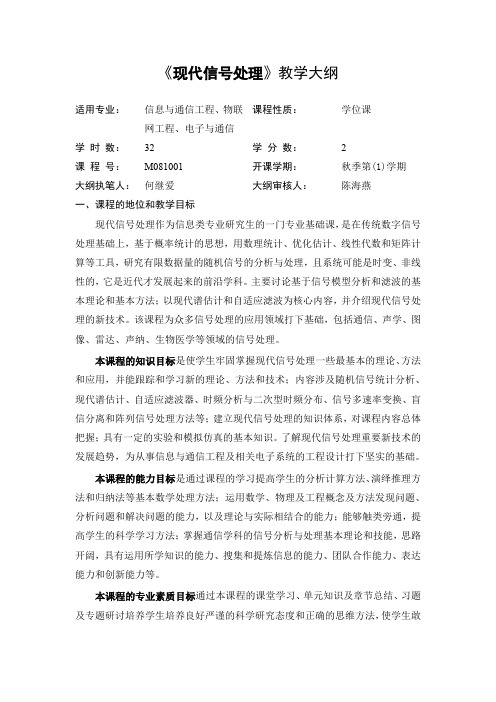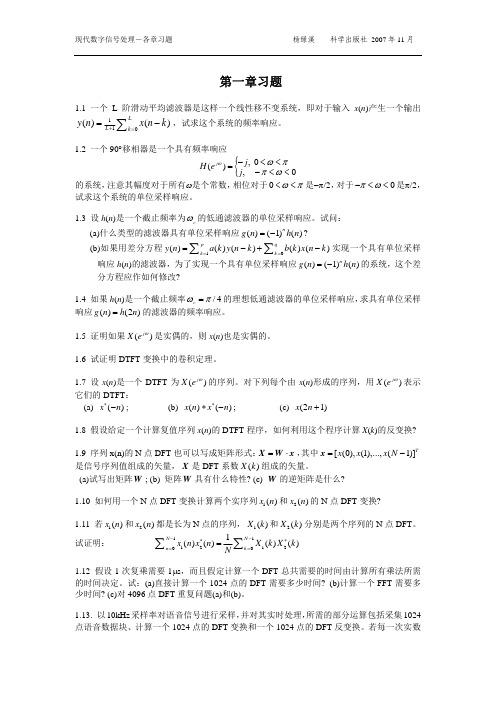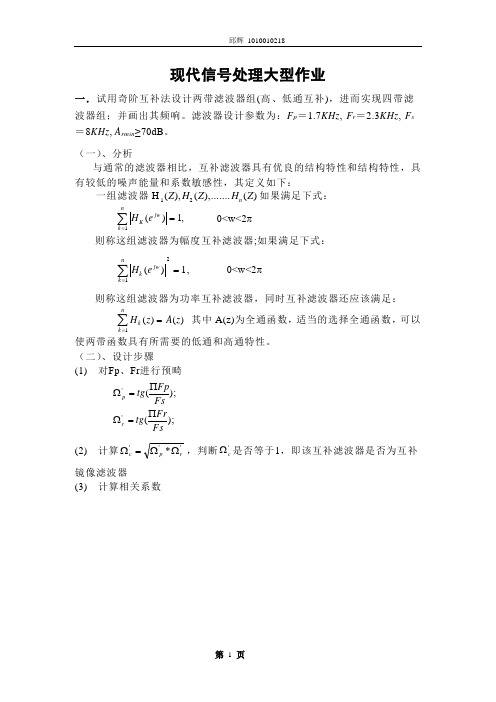现代数字信号处理-基于LMS线性预测
LMS线性预测matlab算法及simulink

LMS线性预测matlab算法及simulink概述LMS线性预测算法和simulink的重要性和应用领域LMS(Least Mean Squares)算法是一种自适应滤波算法,用于线性预测问题。
其原理是通过迭代更新滤波器的权值来最小化预测误差的均方差。
LMS算法的步骤如下:初始化滤波器的权值为零或随机值。
提供待预测的输入信号和目标输出信号。
根据当前输入信号和滤波器的权值计算预测输出信号。
计算预测误差,即目标输出信号与预测输出信号之差。
根据预测误差和当前输入信号更新滤波器的权值。
权值的更新公式为:权值 = 权值 + 步长因子 * 预测误差 * 输入信号。
以下是一个基于matlab实现LMS算法的示例:定义输入信号和目标输出信号input_signal =[1.2.3.4.5];target_output = [2.4.6.8.10];定义输入信号和目标输出信号input_signal = [1.2.3.4.5];target_output = [2.4.6.8.10];定义输入信号和目标输出信号input_signal = [1.2.3.4.5];target_output = [2.4.6.8.10];初始化滤波器的权值filter_weights =zeros(1.length(input_signal));初始化滤波器的权值filter_weights = zeros(1.length(input_signal));初始化滤波器的权值filter_weights = zeros(1.length(input_signal));初始化滤波器的权值filter_weights = zeros(1.length(input_signal));初始化滤波器的权值filter_weights = zeros(1.length(input_signal));初始化滤波器的权值filter_weights = zeros(1.length(input_signal));设置步长因子step_size = 0.01;设置步长因子step_size = 0.01;设置步长因子step_size = 0.01;设置步长因子step_size = 0.01;迭代更新滤波器的权值for i = 1:length(input_signal)。
《现代信号处理》教学大纲

《现代信号处理》教学大纲适用专业:信息与通信工程、物联课程性质:学位课网工程、电子与通信学时数:32 学分数: 2课程号:M081001 开课学期:秋季第(1)学期大纲执笔人:何继爱大纲审核人:陈海燕一、课程的地位和教学目标现代信号处理作为信息类专业研究生的一门专业基础课,是在传统数字信号处理基础上,基于概率统计的思想,用数理统计、优化估计、线性代数和矩阵计算等工具,研究有限数据量的随机信号的分析与处理,且系统可能是时变、非线性的,它是近代才发展起来的前沿学科。
主要讨论基于信号模型分析和滤波的基本理论和基本方法;以现代谱估计和自适应滤波为核心内容,并介绍现代信号处理的新技术。
该课程为众多信号处理的应用领域打下基础,包括通信、声学、图像、雷达、声纳、生物医学等领域的信号处理。
本课程的知识目标是使学生牢固掌握现代信号处理一些最基本的理论、方法和应用,并能跟踪和学习新的理论、方法和技术;内容涉及随机信号统计分析、现代谱估计、自适应滤波器、时频分析与二次型时频分布、信号多速率变换、盲信分离和阵列信号处理方法等;建立现代信号处理的知识体系,对课程内容总体把握;具有一定的实验和模拟仿真的基本知识。
了解现代信号处理重要新技术的发展趋势,为从事信息与通信工程及相关电子系统的工程设计打下坚实的基础。
本课程的能力目标是通过课程的学习提高学生的分析计算方法、演绎推理方法和归纳法等基本数学处理方法;运用数学、物理及工程概念及方法发现问题、分析问题和解决问题的能力,以及理论与实际相结合的能力;能够触类旁通,提高学生的科学学习方法;掌握通信学科的信号分析与处理基本理论和技能,思路开阔,具有运用所学知识的能力、搜集和提炼信息的能力、团队合作能力、表达能力和创新能力等。
本课程的专业素质目标通过本课程的课堂学习、单元知识及章节总结、习题及专题研讨培养学生培养良好严谨的科学研究态度和正确的思维方法,使学生敢于提出问题、善于分析问题和解决问题的能力及具有团队合作精神。
毕业设计(论文)-lms及rls自适应干扰抵消算法的比较[管理资料]
![毕业设计(论文)-lms及rls自适应干扰抵消算法的比较[管理资料]](https://img.taocdn.com/s3/m/e45ae55891c69ec3d5bbfd0a79563c1ec4dad715.png)
前言自适应信号处理的理论和技术经过40 多年的发展和完善,已逐渐成为人们常用的语音去噪技术。
我们知道, 在目前的移动通信领域中, 克服多径干扰, 提高通信质量是一个非常重要的问题, 特别是当信道特性不固定时, 这个问题就尤为突出, 而自适应滤波器的出现, 则完美的解决了这个问题。
另外语音识别技术很难从实验室走向真正应用很大程度上受制于应用环境下的噪声。
自适应滤波的原理就是利用前一时刻己获得的滤波参数等结果, 自动地调节现时刻的滤波参数, 从而达到最优化滤波。
自适应滤波具有很强的自学习、自跟踪能力, 适用于平稳和非平稳随机信号的检测和估计。
自适应滤波一般包括3个模块:滤波结构、性能判据和自适应算法。
其中, 自适应滤波算法一直是人们的研究热点, 包括线性自适应算法和非线性自适应算法, 非线性自适应算法具有更强的信号处理能力, 但计算比较复杂, 实际应用最多的仍然是线性自适应滤波算法。
线性自适应滤波算法的种类很多, 有RLS自适应滤波算法、LMS自适应滤波算法、变换域自适应滤波算法、仿射投影算法、共扼梯度算法等[1]。
其中最小均方(Least Mean Square,LMS)算法和递归最小二乘(Recursive Least Square,RLS)算法就是两种典型的自适应滤波算法, 它们都具有很高的工程应有价值。
本文正是想通过这一与我们生活相关的问题, 对简单的噪声进行消除, 更加深刻地了解这两种算法。
我们主要分析了下LMS算法和RLS算法的基本原理, 以及用程序实现了用两种算法自适应消除信号中的噪声。
通过对这两种典型自适应滤波算法的性能特点进行分析及仿真实现, 给出了这两种算法性能的综合评价。
1 绪论自适应噪声抵消( Adaptive Noise Cancelling, ANC) 技术是自适应信号处理的一个应用分支, 年提出, 经过三十多年的丰富和扩充, 现在已经应用到了很多领域, 比如车载免提通话设备, 房间或无线通讯中的回声抵消( AdaptiveEcho Cancelling, AEC) , 在母体上检测胎儿心音, 机载电子干扰机收发隔离等, 都是用自适应干扰抵消的办法消除混入接收信号中的其他声音信号。
Kalman滤波__LMS算法__RLS算法_清华大学《现代信号处理》讲义

线性状态模型、高斯噪声 v1 (n), v 2 (n)
Kalman 滤波问题 (一步预报 : 一步预报): 一步预报
无噪声的估计值: 已知含噪数据 y (1),L , y (n) ,求 y (i ) 无噪声的估计值
ˆ ⑴ i = n (滤波 ):已知 y (1),L , y ( n ),求 y ( n ) ˆ ⑵ i < n (平滑 ):已知 y (1),L , y ( n ),求 y (i ), i < n ˆ ⑶ i > n (预测):已知 y (1), L , y ( n ),求 y (i ), i > n ˆ 一步预测:已知 y (1),L , y ( n ),求 y ( n+1) ˆ 数学符号: y 1 ( n + 1) = y ( n + 1 | y (1),L , y ( n ) )
要求不同时间的输入信号向量 u ( n ) 线性 独立 [因为瞬时梯度向量为 e* ( n )u ( n )]。
LMS 算法的均值收敛 µ ( n )的选择 LMS 算法的均方收敛
E {e( n )} = 0
均值收敛: 均值收敛:
E {w ( n )} = w opt = R −1r
均方收敛: 均方收敛: E w ( n ) − w opt
k (1, 0) = E { x 2 ( n )} = E { x 2 (1)} = P0
依次可以递推出 g (1), k (2,1); g (2), k (3, 2);L
4.4 LMS自适应算法 LMS自适应算法
LMS: Least Mean Squares
随机优化问题 Wiener 滤波器 滤波器: 最陡下降法
新息方法: 新息方法: 新息 (innovation)
现代数字信号处理实验报告

现代数字信号处理实验报告1、估计随机信号的样本自相关序列。
先以白噪声()x n 为例。
(a) 产生零均值单位方差高斯白噪声的1000个样点。
(b) 用公式:9991ˆ()()()1000x n r k x n x n k ==-∑估计()x n 的前100个自相关序列值。
与真实的自相关序列()()x r k k δ=相比较,讨论你的估计的精确性。
(c) 将样本数据分成10段,每段100个样点,将所有子段的样本自相关的平均值作为()x n 自相关的估值,即:999001ˆ()(100)(100) , 0,1,...,991000x m n r k x n m x n k m k ===+-+=∑∑与(b)的结果相比,该估计值有什么变化?它更接近真实自相关序列()()x r k k δ=吗?(d) 再将1000点的白噪声()x n 通过滤波器11()10.9H z z-=-产生1000点的y (n ),试重复(b)的工作,估计y (n )的前100个自相关序列值,并与真实的自相关序列()y r k 相比较,讨论你的估计的精确性。
仿真结果:(a)图1.1 零均值单位方差高斯白噪声的1000个样本点分析图1.1:这1000个样本点是均值近似为0,方差为1的高斯白噪声。
(b)图1.2 ()x n的前100个自相关序列值分析上图可知:当k=0时取得峰值,且峰值大小比较接近于1,而当k≠0时估计的自相关值在0附近有小幅度的波动,这与真实自相关序列r(k)=δ(k)x比较接近,k≠0时估计值非常接近0,说明了估计的结果是比较精确的。
(c)图1.3基于Bartlett 法的前100个自相关序列值与(b)的结果相比,同样在k=0时达到峰值,k ≠0时0值附近上下波动;估计值的方差比较小,随着k 的增大波动幅度逐渐变小,在k 较大时它更接近真实自相关序列()()x r k k δ=。
即采用分段方法得到的自相关序列的估计值更加接近r x (k)=δ(k)。
LMS算法的简单研究

包括: (a)计算线性滤波器输出对输入信号的响应; (b)通过比较输出结果与期望响应产生估计误差。 2)自适应过程 根据估计误差自动调整滤波器参数。 下面简单简绍下 LMS 算法的基本步骤: 1、设置变量和参量: x(n)为输入向量,或称为训练样本 w(n)为权值向量 b(n)为偏差 d(n)为期望输出 y(n)为实际输出 u 为步长因子 n 为迭代次数 2、初始化,赋给 w(0)一个较小的随机非零值,令 n=0 ; 3、对于一组输入样本 x(n)和对应的期望输出 d,计算 e(n)=d(n)-x(n)w(n) w(n+1)=w(n)+ux(n)e(n) 4、判断是否满足条件,若满足算法结束,若否 n 增加 1,转入第 3 步继续执行。 由上边的权值系数更新过程可以看出,上 LMS 算法具有算法简单、每步迭代 计算量小、所需存储量小等特点,但是 LMS 算法的收敛速度一般较慢。另外 LMS 算法还有一些改进算法如归一化 LMS (NLMS)算法等。
随机性,因而实验中需进行多次 LMS 算法迭代,最后取平均。这里取实验次 数 M 为 80。 本实验将分四个步骤完成。 首先, 实验开始先定义参变量 M、 N 和 w=zeros(M,N,3,2)与 f=zeros(M,N,3,2), 括号里的 3 和 2 分别用来控制 3 种步长因子和 a 的两个不同参数。 然后,对不同的参数 a、不同的步长因子 u 和不同的试验次数 M 分别进行 N 次迭代来获得每个点的权值系数。 其次, 对于不同的参数 a 和步长因子分别计算它们的 M 次集平均权值特性和 均方误差特性。 最后, 分别绘出该一阶自适应预测器的权值和均方误差瞬时特性图与不同步 长因子下的学习曲线图。 本次实验的程序如下所示:
一、实验题目
For this computer experiment involving the LMS algorithm, use a first-order, autoregressive (AR) process to study the effects of ensemble averaging on the transient characteristics of the LMS algorithm for real data. Consider an AR process of order one, described by the difference equation
LMSmatlab

自适应信号处理前言在这几十年里,数字信号处理技术取得了飞速发展,特别是字适应信号处理技术以其计算简单、收敛速度快等许多优点而广泛被使用。
它通过起内部参数的最优化来自动改变其特性。
自适应滤波算法在统计信号处理的许多应用中都是非常重要的。
本论文主要对自适应滤波这一重要的课题展开研究和讨论,在算法原理、算法性能分析和通过计算机仿真来说明其各自算法的优越性,在每一个算法中的通过收敛性、学习曲线和失调分析这三个方面来论述。
这里主要对LMS算法及一些改进的LMS算法(NLMS算法、变步长LMS算法、变换域LMS算法)之间的不同点进行了比较,在传统的LMS算法的基础上发展了LMS算法的应用。
另一方面又从RLS算法的分析中对其与LMS算法的不同特性进行了比较。
这篇论文主要围绕算法的优缺点、收敛性等方面进行了横向和纵向比较得出一些有益的结论。
在自适应信号处理技术的基础上对其算法的简单在某些方面的应用作了说明。
对当前自适应信号处理中比较前沿的盲自适应信号处理做了原理上的介绍和分析。
由于知识水平有限对卡尔曼滤波、自适应神经网络、QR分解等没有作为研究对象。
在以后的工作中,在这些方面还需展开学习和研究。
目录前言 (1)目录 (2)一绪论 (4)1本论文的研究内容 (4)2自适应滤波器的基本原理 (4)3自适应滤波理论与算法 (5)二最小均方(LMS)自适应算法 (8)1 LMS算法的基本原理............... (8)2 最小均方(LMS)自适应算法性能分析 (10)3 仿真结果分析 (12)三归一化LMS算法 (14)1归一化LMS算法原理与性能分析 (14)2仿真结果分析 (16)四可变步长LMS自适应滤波算法 (18)1可变步长LMS算法原理 (18)2算法性能分析 (18)五变换域LMS自适应算法 (21)1基本原理 (21)2与普通LMS自适应滤波器之间的关系 (22)3变换域LMS算法的收敛性能 (22)六最小二乘自适应滤波器 (24)1递推最小二乘(RLS)算法 (24)2仿真结果分析 (26)3 RLS算法与LMS算法的比较 (27)七格型自适应滤波器 (35)八递归型(IIR型)自适应滤波器 (39)九盲自适应均衡 (41)1 Godard盲自适应均衡算法 (41)2过采样与独立分量分析得盲均衡算法 (43)十应用 (45)1自适应均衡器 (45)2 自适应陷波器 (46)3 自适应滤波器 (46)总结与感谢 (48)参考文献 (49)附录:matlab程序代码 (50)附录:翻译 (57)附录:翻译原文 (67)一.绪论1本论文的研究内容自适应滤波是近30年以来发展起来的一种最佳滤波方法。
《现代数字信号处理》各章习题-电子文本

y (n) = x(n) + f (n) ,其中 f (n) 是已知的确定性序列。试求 y (n) 的均值 my (n) 和自相
关 ry ( k , l ) 。 2.3 设离散时间随机过程 x(n) 是如下产生: x( n) =
2
k =1
∑ a(k ) x(n − k ) + w(n) ,其中 w(n) 是
1 −1 1 z ) /(1 − z −1 ) ,它受零均 2 3 值的指数相关噪声 x(n)的激励产生随机过程 y ( n) = x( n) ∗ h( n) 。已知 x(n)的自相关序列 1 k 为 rx (k ) = ( ) ,试求: 2 (a) y (n) 的功率谱 Py ( z ) ; (b) y (n) 的自相关序列 ry (k ) ;
N N ), n = 0,1,..., − 1 ,其中 N 是偶数。 2 2 (a) 证明 x(n) 的 N 点 DFT 仅有奇次谐波,即:k 为偶数时, X (k ) = 0 。 (b) 证明如何由一个经过适当调整的序列的 N/2 点 DFT 求得 x(n) 的 N 点 DFT。
1.18 一个特定的计算机辅助滤波器设计的结果是如下的二阶因果滤波器: 1 + 2 z −1 + z −2 H ( z) = 1 − 2 z −1 + 1.33 z −2 试证明这个滤波器是不稳定的,并求一个和 H ( z ) 有相同幅频响应的因果稳定滤波器。 1.19 一个离散时间线性移不变系统的系统函数是 H ( z ) ,假设 H ( z ) 是 z 的有理函数,且 H ( z ) 是因果稳定的。试判断下面哪个系统是因果的,哪个是稳定的: (a) G ( z ) = H ( z ) H ∗ ( z ∗ ) 。 (c) G ( z ) = H ( z −1 ) 。 (b) G ( z ) = H ' ( z ) ,这里 H ' ( z ) = (d) G ( z ) = H (− z )
基于LMS自适应滤波的心电信提取

数字信号处理课程报告题目:基于LMS自适应滤波在胎儿心电监护中的应用仿真院系:专业:姓名:学号:摘要自适应数字滤波器和维纳滤波器一样,都是符合某种准则的最佳滤波器。
维纳滤波器的参数是固定的,适用于平稳随机信号的最佳滤波。
在实际设计中,常常无法知道输入信号是否平稳以及信号和噪声统计分布规律,且统计特性还会变化,因此实现最佳滤波是困难的。
1967年Widrow等人提出自适应滤波器的设计方法,它的参数可以自动地按照某种准则调整到最佳滤波,实现时不需要任何关于信号和噪声的先验统计知识,尤其当输入统计特性变化时,自适应滤波器都能调整自身的参数来满足最佳滤波器的需要。
1975年,威德诺(B.Widrow)和Hof提出的最小均方(LMS )算法,是用梯度的估计值代替梯度的精确值,这种算法简单易行,获得了广泛的应用,对自适应技术的发展起了极大的作用。
本论文主要是基于LMS自适应滤波在胎儿心电监护中的应用仿真。
通过简要阐述自适应滤波器和LMS的相关原理,结合胎儿心电监护的应用,在MATLAB的平台上使用自适应滤波器的方法从母婴混合心电信号中提取纯净胎儿信号并绘出图谱。
通过仿真结果,分析几个参数(步长、滤波器阶数)对实验结果的影响,进一步加深对自适应滤波和LMS的学习理解。
关键词:自适应数字滤波器;最佳滤波器;威德诺;最小均方算法;梯度;胎儿心电监护; MATLABABSTRACTThe adaptive digital filter and Wiener filter are the best filters to meet some criteria. The parameters of the Wiener filter are fixed, and are suitable for the optimal filtering of stationary random signals. In practice, it is often difficult to know whether the input signal is stationary and the signal and noise statistics distribution law, and the statistical characteristics will change, so it is difficult to achieve the best filter. In 1967, Widrow et al proposed the designmethod of the adaptive filter. Its parameters can be adjusted to the best filter automatically according to some criterion. The adaptive filter can adjust its parameters to meet the needs of the optimal filter. In 1975, the least mean square (LMS) algorithm proposed by Widno (B.Widrow) and Hof is the exact value of the gradient. This algorithm is simple and easy to operate. It has been widely used and has a great effect on the development of adaptive technology. This thesis is based on the application of LMS adaptive filter in fetal ECG monitoring. In this paper, the principle of adaptive filter and LMS is introduced, and the application of fetal ECG monitoring is introduced. The method of adaptive filter is used in the MATLAB platform to extract pure fetal signal and draw the map from the mixed ECG signal. Through the simulation results, the effects of several parameters (step size and filter order) on the experimental results are analyzed, and the learning and understanding of the adaptive filter and LMS is further deepened. Keywords:Adaptive digital filter; filter; weed Connaught; least mean square algorithm; gradient; fetal ECG monitoring; MATLAB目录第一章绪论 (1)1.1 自适应滤波器的原理 (1)1.2 自适应滤波算法 (2)第二章胎儿心电监护应用仿真 (5)2.1 概述 (5)2.2 实验步骤及程序 (6)2.3 实验仿真结果与分析 (9)2.3.1实验仿真结果 (9)2.3.2 实验结果分析 (9)结束语 (10)第一章绪论1.1 自适应滤波器的原理所谓的自适应滤波,就是利用前一时刻以获得的滤波器参数的结果,自动的调节现时刻的滤波器参数,以适应信号和噪声未知的或随时间变化的统计特性,从而实现最优滤波。
第08讲_码本激励线性预测编码

随机激励线性预测合成模型的 基本思想
短时预测器STP的的传递函数
其中,ai为预测器系数,p为预测器阶数,一 般介于8-16之间,基于CELP的编码器中通常 取10。短时合成器也就是LPC共振峰合成滤波 器,其传递函数为:
Байду номын сангаас
,A(z)是线性预测误差滤波器,预测系数ai ,一般每隔20-30ms修正一次。
Qcelp13k 算法的提出2
和Qcelp8k 一样,Qcelp13k 将原始语音分割为20ms 的帧,每帧含有以8k 采样的160 个采样点。编码器 对每帧的输入数据,生成一个压缩数据的传送包作 为输出。每一帧被编码为四个不同的数据速率之一 全速率时传输包有 266bits , 1/2 速率有 124bits , 1/4 速率为54bits,1/8 速率为20bits。 因此,数据传输速率分别为 13.3 kbps , 6.2 kbps , 2.7 kbps 和1 kbps。Qcelp13k 为了获得更好的语音 质量,在Qcelp8k 基础上做了很多的改进与增强。但 复杂度也非常之高,且损失了50%的带宽容量。
而人的声管相当于一组滤波器,对不同的激励产生 不同的响应,形成特定声音的输出。 为了提高重建话音的自然度,编码端可以增加一组 预测滤波器,采用闭环LPC结构,由特征参数激励 得到预测信号,将此信号与原信号s(n)相减得到残 差信号e(n),把此信号与有关参数一并编码传送, 在解码端进行误差修正可有效改善语音质量。
随机激励线性预测合成模型
利用几乎是白噪声的信号激励两个时变的线性递 归滤波器,在每个滤波器反馈环路上有一个预测 器,其中一个是长时预测器(或基音预测器)LTP (Long-Term Predictor)P(z),用来生成浊音语 音的音调结构(谱的细致结构),另一个是短时 预测器STP(Short-Term Predictor)F(z),用来 恢复语音的短时谱包络。 源自于它的逆过程,如图2-1(b)。F(z)用于去 除语音信号的近样点冗余度;P(z)用于去除语 音信号的远样点冗余度,经过两级预测得到的归 一化残差信号近似服从标准正态分布。
LMS算法及改进

浅析LMS算法的改进及其应用摘要:本文简单介绍了LMS算法,以及为了解决基本LMS算法中收敛速度和稳态误差之间的矛盾,提出了一种改进的变步长LMS 算法,并将其应用于噪声抵消和谐波检测中去。
关键字:LMS算法;变步长;噪声抵消;谐波检测引言自适应滤波处理技术可以用来检测平稳和非平稳的随机信号,具有很强的自学习和自跟踪能力,算法简单易于实现,在噪声干扰抵消、线性预测编码、通信系统中的自适应均衡、未知系统的自适应参数辨识等方面获得了广泛的应用。
自适应滤波则是利用前一时刻已获得的滤波器参数等结果,自动地调节现时刻的滤波器参数,以适应信号和噪声未知的或随时间变化的统计特性,从而实现最优滤波。
所谓“最优”是以一定的准则来衡量的,根据自适应滤波算法优化准则不同,自适应滤波算法可以分为最小均方误差(LMS)算法和递推最小二乘(RLS)算法两类最基本的算法。
基于最小均方误差准则,LMS算法使滤波器的输出信号与期望输出信号之间的均方误差最小,因此,本文在基本LMS算法基础上,提出一种新的变步长自适应滤波算法,将其应用于噪声抵消和谐波检测中去。
一.LMS算法LMS算法即最小均方误差(least-mean-squares) 算法,是线性自适应滤波算法,包括滤波过程和自适应过程。
基于最速下降法的LMS算法的迭代公式如下:e ( n) = d ( n)- w ( n - 1) x ( n) (1)w ( n) =w ( n - 1) + 2μ( n) e ( n) x ( n) (2)式中,x ( n)为自适应滤波器的输入;d ( n)为参考信号;e ( n)为误差;w ( n)为权重系数;μ( n)为步长。
LMS算法收敛的条件为:0 <μ< 1/λmax ,λmax是输入信号自相关矩阵的最大特征值。
二.LMS算法的改进由于LMS算法具有结构简单,计算复杂度小,性能稳定等特点,因而被广泛地应用于自适应均衡、语音处理、自适应噪音消除、雷达、系统辨识及信号处理等领域。
现代信号处理大作业

现代信号处理大型作业一.试用奇阶互补法设计两带滤波器组(高、低通互补),进而实现四带滤波器组;并画出其频响。
滤波器设计参数为:F p =1.7KHz , F r =2.3KHz , F s =8KHz , A rmin ≥70dB 。
(一)、分析与通常的滤波器相比,互补滤波器具有优良的结构特性和结构特性,具有较低的噪声能量和系数敏感性,其定义如下:一组滤波器H 12(),(),.......()Z H Z H Z n 如果满足下式:He Kjw k n(),==∑110<w<2π 则称这组滤波器为幅度互补滤波器;如果满足下式:He kjw k n()=∑=121, 0<w<2π则称这组滤波器为功率互补滤波器,同时互补滤波器还应该满足:Hz A z kk n()()=∑=1其中A(z)为全通函数,适当的选择全通函数,可以使两带函数具有所需要的低通和高通特性。
(二)、设计步骤(1) 对Fp 、Fr 进行预畸);();(''FsFrtg FsFptg r p ∏=Ω∏=Ω(2) 计算'''*r p c ΩΩ=Ω,判断'c Ω是否等于1,即该互补滤波器是否为互补镜像滤波器(3) 计算相关系数⎪⎩⎪⎨⎧-==+++=+-=-=ΩΩ=--=偶数)N 为(;21奇数)N 为 (;;lg /)16/1lg(;150152;1121;1;;])110)(110[(1213090500''02'''211-min1.0min1.0i i u q k N q q q q q k k q k k k k rp Ar Ap;)2cos()1(21))12(sin()1(21)1(21'2∑∑∞=∞=+-++-=Ωm mm m m m m i u Nm q u Nm q q ππ;42⎥⎦⎤⎢⎣⎡=N N;221N N N -⎥⎦⎤⎢⎣⎡=;)/1)(1(2'2'k k v i i i Ω-Ω-=12'1212,1;12N i v i i i =Ω+=--α 22'22,1;12N i v iii =Ω+=β (4) 互补镜像滤波器的数字实现;22i ii A αα+-=;22iii B ββ+-=1221,1;1)(N i ZA Z A Z H i i i =++=∏--22212,1;1)(N i ZB Z B Z Z H i i i =++=∏--- )];()([21)(21Z H Z H Z H L +=(三)、程序与结果 1. 二带滤波器组 (1) 源程序: clear; clf;Fp=1700;Fr=2300;Fs=8000; Wp=tan(pi*Fp/Fs); Wr=tan(pi*Fr/Fs); Wc=sqrt(Wp*Wr); k=Wp/Wr;k1=sqrt(sqrt(1-k^2)); q0=0.5*(1-k1)/(1+k1);q=q0+2*q0^5+15*q0^9+150*q0^13; N=11;N2=fix(N/4); M=fix(N/2); N1=M-N2; for jj=1:M a=0;for m=0:5a=a+(-1)^m*q^(m*(m+1))*sin((2*m+1)*pi*jj/N);%N is odd, u=j end ab=0;for m=1:5b=b+(-1)^m*q^(m^2)*cos(2*m*pi*jj/N); end bW(jj)=2*q^0.25*a/(1+2*b);V(jj)=sqrt((1-k*W(jj)^2)*(1-W(jj)^2/k)); endfor i=1:N1alpha(i)=2*V(2*i-1)/(1+W(2*i-1)^2); endfor i=1:N2beta(i)=2*V(2*i)/(1+W(2*i)^2); endfor i=1:N1a(i)=(1-alpha(i)*Wc+Wc^2)/(1+alpha(i)*Wc+Wc^2); endfor i=1:N2b(i)=(1-beta(i)*Wc+Wc^2)/(1+beta(i)*Wc+Wc^2); endw=0:0.0001:0.5;LP=zeros(size(w));HP=zeros(size(w));for n=1:length(w)z=exp(j*w(n)*2*pi);H1=1;for i=1:N1H1=H1*(a(i)+z^(-2))/(1+a(i)*z^(-2)) ;endH2=1/z;for i=1:N2H2=H2*(b(i)+z^(-2))/(1+b(i)*z^(-2));endLP(n)=abs((H1+H2)/2);HP(n)=abs((H1-H2)/2);endplot(w,LP,'b',w,HP,'r');hold on;xlabel('digital frequency');ylabel('amptitude');(2)运行结果:见图1图1 二带数字滤波器组2.四带滤波器组(1)源程序:clf;Fp=1700;Fr=2300;Fs=8000;Wp=tan(pi*Fp/Fs);Wr=tan(pi*Fr/Fs);Wc=sqrt(Wp*Wr);k=Wp/Wr;k1=sqrt(sqrt(1-k^2));q0=0.5*(1-k1)/(1+k1);q=q0+2*q0^5+15*q0^9+150*q0^13;N=11;N2=fix(N/4);M=fix(N/2);N1=M-N2;for jj=1:Ma=0;for m=0:5a=a+(-1)^m*q^(m*(m+1))*sin((2*m+1)*pi*jj/N); % N is odd, u=jendb=0;for m=1:5b=b+(-1)^m*q^(m^2)*cos(2*m*pi*jj/N);endW(jj)=2*q^0.25*a/(1+2*b);V(jj)=sqrt((1-k*W(jj)^2)*(1-W(jj)^2/k));Endfor i=1:N1alpha(i)=2*V(2*i-1)/(1+W(2*i-1)^2);endfor i=1:N2beta(i)=2*V(2*i)/(1+W(2*i)^2);endfor i=1:N1a(i)=(1-alpha(i)*Wc+Wc^2)/(1+alpha(i)*Wc+Wc^2);endfor i=1:N2b(i)=(1-beta(i)*Wc+Wc^2)/(1+beta(i)*Wc+Wc^2);endw=0:0.0001:0.5;LLP=zeros(size(w));LHP=zeros(size(w));HLP=zeros(size(w));HHP=zeros(size(w));for n=1:length(w)z=exp(j*w(n)*2*pi);H1=1;for i=1:N1H1=H1*(a(i)+z^(-2))/(1+a(i)*z^(-2)) ;endH21=1;for i=1:N1H21=H21*(a(i)+z^(-4))/(1+a(i)*z^(-4)) ;H2=1/z;for i=1:N2H2=H2*(b(i)+z^(-2))/(1+b(i)*z^(-2));endH22=1/(z^2);for i=1:N2H22=H22*(b(i)+z^(-4))/(1+b(i)*z^(-4));endLP=((H1+H2)/2);HP=((H1-H2)/2);LLP(n)=abs((H21+H22)/2*LP);LHP(n)=abs((H21-H22)/2*LP);HHP(n)=abs((H21+H22)/2*HP);HLP(n)=abs((H21-H22)/2*HP);endplot(w,LLP,'b',w,LHP,'r',w,HLP,'k',w,HHP,'m')hold onxlabel('digital frequency');ylabel('amptitude');(2)运行结果:见图2图2 四带数字滤波器组二、根据《现代数字信号处理》第四章提供的数据,试用如下方法估计其功率谱,并画出不同参数情况下的功率谱曲线:1)Levison算法2)Burg算法3) ARMA 模型法 4) MUSIC 算法 1 Levinson 算法Levinson 算法用于求解Yule-Walker 方程,是一种按阶次进行递推的算法,即首先以AR (0)和AR (1)模型参数作为初始条件,计算AR (2)模型参数;然后根据这些参数计算AR (3)参数,等等,一直到计算出AR (p )模型参数为止,需要的运算量数量级为2p ,其中p 为AR 模型的阶数。
LMS算法原理及推导

E {W (k + 1)} = E {W (k )} + 2μ E {ε (k ) X (k )}
= E {W (k )} + 2μ E { X (k )[d (k ) − X T (k )W (k )]} = ( I − 2μ RXX ) E {W (k )} + 2μ RXd
式中, I 为单位矩阵, RXX = E X (k ) X T X T (k ) 和 Rxd = E { X (k )d (k )} 。 当 k = 0 时, (8-1-17)
和,即
V (k ) = V n (k ) + V l (k )
噪声离差 V (k ) 和滞后离差 V (k ) 具有以下递推式:
n l
(8-1-24) (8-1-25) (8-1-26) (8-1-27)
V n (k ) = [ I − 2μ X (k ) X T (k )]V n (k − 1) + μ X T (k )eo (k ) V (k ) = [ I − 2μ X (k ) X (k )]V (k − 1) − T (k )
长的时间才会收敛到最佳权值。克服这一困难的方法之一是产生正交数据。 基本 LMS 自适应算法如下: 初始化: W (0) = 0; R(0) = I ; 1 选择 μ : 0 < μ < λmax For k = 1 to n final do :
0<μ <
1
W (k ) = W (k − 1) + 2μ[ x(k ) − W T (k − 1) X (k )] X (k )
(8-1-21a)
= Q ( I − 2μ ∑)i Q −1
(2)
lim ∑ ( I − 2 μ Q ∑ Q −1 )i = ∑ Q ( I − 2μ ∑ )Q −1
lms算法基本思想及原理

lms算法基本思想及原理
一、最小均方算法(LMS)概述1959年,Widrow和Hoff在对自适应线性元素的方案一模式识别进行研究时,提出了最小均方算法(简称LMS算法)。
LMS算法是基于维纳滤波,然后借助于最速下降算法发展起来的。
通过维纳滤波所求解的维纳解,必须在已知输入信号与期望信号的先验统计信息,以及再对输入信号的自相关矩阵进行求逆运算的情况下才能得以确定。
因此,这个维纳解仅仅是理论上的一种最优解。
所以,又借助于最速下降算法,以递归的方式来逼近这个维纳解,从而避免了矩阵求逆运算,但仍然需要信号的先验信息,故而再使用瞬时误差的平方来代替均方误差,从而最终得出了LMS 算法。
因LMS算法具有计算复杂程度低、在信号为平稳信号的环境中的收敛性好、其期望值无偏地收敛到维纳解和利用有限精度实现算法时的稳定性等特性,使LMS算法成为自适应算法中稳定性最好、应用最广泛的算法。
下图是实现算法的一个矢量信号流程图:
图1 LMS算法矢量信号流程图
由图1我们可以知道,LMS算法主要包含两个过程:滤波处理和自适应调整。
一般情况下,LMS算法的具体流程为:
(1)确定参数:全局步长参数以及滤波器的抽头数(也可以称为滤波器阶数)
(2)对滤波器初始值的初始化
(3)算法运算过程:
滤波输出:y(n)=wT(n)x(n)
误差信号:e(n)=d(n)-y(n)
权系数更新:w(n+1)=w(n)+e(n)x(n)
二、性能分析在很大程度上,选取怎样的自适应算法决定着自适应滤波器是否具有好的性能。
因此,对应用最为广泛的算法算法进行性能分析则显得尤为重要。
平稳环境下算法的。
现代数字信号处理学习报告(一)

现代数字信号处理学习报告(一)第一部分 维纳滤波1.1 最优滤波和最有准则1.1.1最优滤波信号处理的目的是从噪声中提取信号,得到不受干扰影响的真正信号。
采用的处理系统称为滤波器。
为了从x(n)中提取或恢复原始信号s(n),需要设计一种滤波器,对x(n)进行滤波,使它的输出y(n)尽可能逼近s(n),成为s(n)的最佳估计,即ˆy(n)s(n)。
这种滤波器称为最佳滤波器。
1.1.2最优准则最大输出信噪比准则->匹配滤波器最小均方误差准则 误差绝对值的期望值最小误差绝对值的三次或高次幂的期望值最小1.2 维纳滤波维纳滤波(wiener filtering) 是一种基于最小均方误差准则、对平稳过程的最优估计器。
这种滤波器的输出与期望输出之间的均方误差为最小,因此,它是一个最佳滤波系统。
它可用于提取被平稳噪声所污染的信号。
2min[|()|]E e n min [|()|]E e n min[|()|]kE e n1.3 维纳滤波的标准方程维纳滤波器是一个线性非移变系统,设其冲激响应为h(m),输入为()()()x n s n n υ=+,则有0ˆ()()()()m y n sn h m x n m ∞===-∑。
式中,冲激响应h(m)按最小均方误差准则确定,其中, e(n)表示真值与估计值之间的误差,则ˆ()()()e n s n sn =-。
为了达到最小均方误差准则的目标,即求得使()2ˆE s s ⎡⎤-⎣⎦最小的i h ,令()2ˆE s s ⎡⎤-⎣⎦对i h 的导数为零,即 {}[]2(n)(n)2(n)2(n)(n )0()()E e e E e E e x i h i h i ∂⎡⎤∂==--=⎢⎥∂∂⎣⎦由此得到,[](n)(n )0,E e x i i -=∀。
此式说明,若使滤波器的均方误差达到,则误差信号与输入信号正交,这就是通常所说的正交性原理。
正交性原理的重要意义:提供了一个数学方法,用以判断线性滤波系统是否工作于最佳状态。
LMS自适应线性预测算法

LMS自适应线性预测算法LMS(最小均方)自适应线性预测算法是一种常用的信号处理算法,用于估计未知信号的值。
它基于线性模型,通过逐步地调整权重以最小化预测误差的均方差来实现预测。
在该算法中,自适应性体现在权重的自适应更新上,使得算法能够适应不断变化的信号环境。
LMS算法的基本思想是,通过输入信号的相关性来构造一个线性模型,并使用已知的输入信号和相应的输出信号来估计模型的权重。
这样,当没有给定输出信号时,我们可以使用该模型来预测未知信号的值。
预测误差被定义为实际输出信号与预测输出信号之间的差异。
LMS算法的核心是权重的自适应更新。
为了通过最小化均方误差来优化权重,算法使用了梯度下降的思想。
具体来说,算法使用误差信号(预测输出与实际输出的差异)来调整每个权重的值,使得误差信号的均方差尽可能小。
LMS算法的更新规则如下:w(n+1)=w(n)+μ*e(n)*x(n)其中,w(n)是上一次权重的值,w(n+1)是当前权重的值,μ是步长参数(控制权重更新的速度),e(n)是误差信号,x(n)是输入信号。
LMS算法的步骤如下:1.初始化权重w(0)为一个适应信号长度的零向量。
2.对于每一个时间步n,计算输出y(n):y(n)=w^T(n)x(n),其中x(n)是输入信号,w^T(n)是权重向量的转置。
3.计算误差信号e(n):e(n)=d(n)-y(n),其中d(n)是实际输出信号。
4.更新权重w(n+1):w(n+1)=w(n)+μ*e(n)*x(n)。
5.重复步骤2-4,直到达到预定的停止条件(如达到最大迭代次数、误差信号小于一些阈值等)。
LMS算法的性能取决于步长参数μ的选择。
如果步长参数过小,算法收敛速度较慢;如果步长参数过大,算法可能发散。
因此,在实际应用中,需要仔细选择适当的步长参数。
LMS算法的优点是简单、易于实现,对于大多数实时信号处理应用而言,具有较高的计算效率。
此外,LMS算法对于非线性系统也能够进行利用,但是需要注意对非线性情况下的模型做一定的适应。
外文翻译---基于LMS自适应滤波器在直达波消除中的运用

外文翻译学生姓名学号院系电子与信息工程专业电子信息工程指导教师二O一一年六月二日基于LMS 自适应滤波器在直达波消除中的运用徐元军,陶源,王越,单涛电子工程系,信息科学与技术学院,北京理工大学,北京100081,中国摘要:本文介绍了使用最小均方(LMS)算法消除无源雷达收到的直达波。
并由此推导出直达波的模型。
通过使用基于LMS 算法的FIR 自适应滤波器,从而开发出来调频无源雷达的软件解决方案,从而代替了利用硬件对无源雷达的调试。
由此我们获得的一些无源雷达的仿真结果。
这些仿真结果预示着利用LMS 算法消除直达波是十分有效的。
关键字:LMS 算法;自适应滤波器;直达波消除;在以往的雷达系统的研究中,大多数的雷达专家都曾经专注于无源雷达系统,但是只是把它当做只用作为商业电台的广播电台发射器,比如电视和GSM 发射机等。
而这种无源雷达系统的其他的一些潜在运用仅仅只是在一些实验[1]中被介绍.无源雷达系统通常包括一个参考接收器和一个回波接收器。
在实际中,无源雷达的回波接收器通常不仅收到目标的回波,而且也接收到由于多径传播效应而产生的回波。
由于在实际中的雷达的横截面(RCS)的目标通常是非常小的,与多径传播效应而产生的回波相比,目标的回波是非常微弱的,这使得检测信号变得十分困难。
这就是为什么在这种情况下,实现目标的检测成为一项极其艰巨的任务。
在实际中,无源雷达设备使用了各种各样的不同方案来解决这个问题[2][3]。
但是这些方法都需要添加特殊的硬件才能够实现直达波的消除。
为了解决这个问题,现在我们可以采用软件的方法来实现直达波的消除。
在过去几十年的滤波器理论研究中,自适应信号处理经过不断的发展已经成为了现在研究的热门领域之一。
越来越多的自适应理论被广泛地运用于实际生活和生产中。
实际中的一些重要的运用主要包括自适应线性预测,回波消除,自适应通道均衡等。
自适应理论的这些运用使我们意识到也可以采用自适应滤波器来实现直达波消除。
现代信号处理

课程简介
现代信号处理是“信息与通信工程 信息与通信工程”一级学 科“通信与信息系统”和“信号与信息处理” 两个专业的学位课,“电子与通信工程 电子与通信工程”专 业 门重要的学位专业基 课 作为信息处 业一门重要的学位专业基础课,作为信息处 理与现代通信的基础,它对信息科学的发展 起着重要作用 先修课程:随机过程、最优化方法、数字信 先修课程 号处理
现代信号处理 8
lifei@
信号处理的典型应用
• • • • • • 1.语音处理 2.图像处理 3.通信 4 航空航天 4.航空航天 5.生物医学 ……
语音处理
• • • • • 最早采用DSP的领域之一 语音编码 语音合成 语音识别 语音增强
lifei@
lifei@
图像处理
• 数据压缩 • 图像复原 • 清晰化与增强
信号处理方法(小结)
• 方法分类
– – – – 基于变换的方法(Fourier 变换) 基于统计的方法 (Bayes准则) 基于模型的方法 (信号模型AR, AR MA MA, ARMA) 基于智能/机器学习的方法 (盲方法,对信号所知甚少)
现代信号处理 - 研究内容
DSP DSP: 两大支柱,表层信息 –快速变换 –数字滤波 MSP MSP: 四大处理, 深层信息 –自适应信号处理(盲,半盲) –现代谱估计(如HOS) –非平稳信号处理(Wavelets) –非线性信号处理(如NNSP)
现代信号处理 20
lifei@
现代信号处理 - 处理方法
• 取决于信号本身(关于对信号本身的知识) • 取决于具体应用
信号处理框图
D S P
现代信号处理 21
ห้องสมุดไป่ตู้
基于LMS算法的自适应线性均衡器设计

基于LMS算法的自适应线性均衡器设计自适应线性均衡器(Adaptive Linear Equalizer)是一种用于解决通信系统中信号传输过程中引起的衰落、多径干扰和色散等问题的数字信号处理技术。
其中,最常用的算法就是最小均方算法(LMS算法)。
本文将对基于LMS算法的自适应线性均衡器设计进行详细探讨,以便进一步理解该技术的原理和应用。
自适应线性均衡器的设计目标就是使得接收到的信号尽可能接近发送信号。
在传输过程中,信号可能受到多径干扰、噪声和失真等因素的影响。
自适应线性均衡器的任务就是根据接收信号的特征自动调整其内部权值,以最小化输出信号与原始信号之间的误差。
LMS算法是一种基于梯度下降的迭代算法,它通过最小化均方(Mean Square Error,MSE)误差来更新权值。
LMS算法的基本思想是根据误差信号的梯度来调整权值,从而最小化误差。
在自适应线性均衡器中,LMS算法的实现需要以下步骤:1.定义输入信号和目标信号:将输入信号表示为x(n),目标信号(即发送信号)表示为d(n)。
2.初始化权值向量:将权值向量w(n)初始化为一个较小的初值,通常为零。
3.计算估计输出:根据当前权值向量,计算自适应线性均衡器的估计输出y(n)。
4.计算误差信号:将估计输出与目标信号进行比较,计算误差信号e(n)。
5.更新权值向量:根据误差信号的梯度计算出权值的变化量,并将其加到当前的权值向量上,得到新的权值向量。
6.重复步骤3到步骤5,直到收敛或达到预设的迭代次数。
自适应线性均衡器的设计中,一些关键问题需要考虑:1.学习率:学习率决定了权值的更新速度,过大的学习率可能导致不稳定性,而过小的学习率则会导致收敛速度过慢。
因此,需要根据实际情况选择合适的学习率。
2.初始权值:初始权值的选择可能会影响算法的收敛速度和性能。
通常可以将初始权值设置为零或一个随机小值,然后通过迭代调整权值。
3.触发更新:权值的更新可以在每个符号周期内进行,也可以在每个数据块周期内进行。
- 1、下载文档前请自行甄别文档内容的完整性,平台不提供额外的编辑、内容补充、找答案等附加服务。
- 2、"仅部分预览"的文档,不可在线预览部分如存在完整性等问题,可反馈申请退款(可完整预览的文档不适用该条件!)。
- 3、如文档侵犯您的权益,请联系客服反馈,我们会尽快为您处理(人工客服工作时间:9:00-18:30)。
现代信号处理基于LMS 算法的线性预测估计小组组长:刘鑫(150408520845)小组成员:刘芳(150408520846)万娇(150408520849)郑熔(150408520848)郭俊(150408520852)任课教师:聂文滨教师所在学院:信息工程学院时间:2015年11月17日摘要现代电子技术发展日新月异,随着数字时代的到来,各种各样的产品层出不穷,在追求高性能的同时,高效的算法越来越得到人们的青睐。
本文对LMS算法及其改进算法进行了研究,主要有LMS算法的线性预测,解相关LMS算法(包括时域解相关算法和变换域解相关算法),自适应LMS算法,并利用matlab 对这几种算法进行了软件仿真,通过仿真结果图把各种LMS算法的性能直观的展现出来。
其中,线性预测是根据已有采样点按照线性函数计算未来某一离散信号的数学方法,线性预测可分为前向性预测和后向性预测。
在线性预测中维纳滤波应用很广泛,包括线性预测器原理,线性预测与AR模型的关系以及线性预测器的AR模型功率谱估计。
在系统分析中,线性预测可以看作是数学建模或者最优化的一部分。
另外,采用不同LMS算法时的结果对影响LMS算法是不同的。
根据参数模型功率谱估计的思想,使用LMS算法,最小均方误差准则得到线性预测系数或LPC系数,从而进行线性预测分析。
关键词:LMS算法;线性预测;matlab软件仿真AbstractDevelopment of modern electronic technology with each passing day, a variety of products emerge in endlessly with the arrival of digital age, in the pursuit of high performance at the same time, the efficient algorithm is more and more get the favour of people.This paper studies the Least Mean Square (LMS) algorithm and its improved algorithm , mainly include the linear prediction of LMS algorithm, the decorrelation LMS algorithm (including the temporal decorrelation algorithm and transform domain decorrelation algorithm), adaptive LMS algorithm, and using matlab software to simulat several algorithms, through the simulation results show the performance of LMS algorithm with all kinds of intuitive.The linear prediction is a mathematical method to calculate a future discrete signal according to the sampling points by the linear function ,linear prediction can be divided into forward prediction and backward prediction.Wiener filtering is widely used in the linear prediction ,including the principle of linear predictor, the relationship between linear prediction and auto-regressive(AR) model and AR model power spectrum estimation of the linear predictor.In system analysis,linear prediction can be seen as part of the mathematical modeling and optimization. In addition, the different results when the LMS algorithm is adopted to affect the LMS algorithm is different. According to the ideas of the parameter model of power spectrum estimation, using the LMS algorithm and the minimum mean square error criterion to obtain the linear prediction coefficients or linear predictive coding(LPC) coefficients, thus a linear predictive analysis is made.Key words: LMS algorithm; Linear prediction; Matlab software simulation第一章绪论1.1论文研究的背景及意义现代电子技术己经由模拟向数字过渡,传统的模拟信号处理正被数字信号处理所代替。
随着数字时代的到来,各种各样的产品层出不穷,在追求高性能的同时,高效的算法越来越得到人们的青睐。
数字滤波是数字信号处理一部分,它除了具有数字信号处理的稳定、重复性好和适应性强等优点外,还具有可预见性和无相位偏差的优点,可用仿真软件来对一个设计预先测试。
实现数字滤波的方法很多,其中,最小均方算法(LMS)应用最广泛,这是因为LMS算法具有低计算复杂度、平稳环境下的收敛性、均值无偏地收敛到维纳解以及利用有限精度实现算法时的稳定性等特性。
由于LMS算法的广泛应用,以及在实际条件下,为解决实际问题,基于LMS算法的新LMS类算法不断出现。
而线性预测估计常用于对语音信号进行分析预测,这一过程是在短时平稳这一现实的假定基础上进行的,即一段语音信号是各态历经的平稳随机过程。
线性预测分析是一种估计精度较高、运算速度较快的语音参数估计方法。
大量的实践证明:线性预测编码(LPC)参数是反映语音信号特征的良好参数。
线性预测分析被普遍应用到语音处理的各个方面。
在线性预测中维纳滤波应用很广泛,包括线性预测器原理,线性预测与AR模型的关系以及线性预测器的AR模型功率谱估计。
线性预测是进行语音信号分析最有效和最流行的分析技术之一,已经在很多语音处理领域中得到了应用,如语音编码、语音合成和语音识别等。
因此,对基于LMS算法的线性预测估计的研究具有很重要的意义。
1.2 LMS算法的发展1.2.1 LMS算法的历史发展及现状1955-1966年期间美国通用公司在研制天线的过程中,为抑制旁瓣,由windows和hoff在60年代初提出了基本LMS算法。
随后又发展出了归一化算法和加遗忘因子LMS算法。
1977年,makjoul提出了格型滤波器,并由此发展出LMS自适应格型滤波器算法。
Herzberg、cohen和be’ery提出了延时LMS(DLMS)算法。
2002年,尚勇,吴顺君,项海格提出了并行延时LMS算法。
此外,还有复数LMS算法、数据块LMS算法等。
LMS算法一直在不断的改进创新,因为LMS算法具有低计算复杂度、在平稳环境中的收敛性好、其均值无偏地收敛到wiener解和利用有限精度实现算法时的稳定性等特性,使LMS算法成为自适应算法中应用最广泛的算法。
由于LMS算法的广泛应用,以及在实际条件下,为解决实际问题,基于LMS算法的新LMS类算法不断出现。
1.2.2 LMS算法的发展前景因LMS算法是自适应滤波器中应用最广泛的算法,所以可以说,自适应滤波的发展前景也就是LMS算法的发展前景。
它主要包括以下几个方面的应用:1、系统辨识和建模(System Identification and Modeling)。
自适应滤波器作为估计未知系统特性的模型。
2、自适应信道均衡(Adaptive Channel Equlization)。
在数字通信中采用自适应信道均衡器,可以减小传输失真,以及尽可能地利用信道带宽。
3、回波消除(Echo Cancellation)。
回波消除就是预先估计一个回波,然后用返回信号来减此回波,从而达到回波消除的目的。
4、线性预测编码(Linear Predictive Coding)。
近年来,对语音波形进行编码,它可以大大降低数据传输率。
在接收端使用LPC分析得到的参数,通过话音合成器重构话音。
时变线性滤波器既当作预测器使用,又当作合成器使用。
5、自适应波束形成(Adaptive Beaamforming)。
自适应束波形成通过调节天线各阵元的加权幅度和相位,来改变阵列的方向图,使阵列天线的主瓣对准期望用户,从而提高接收信噪比,满足某一准则下的最佳接收。
其应用还有噪声中信号的滤波、跟踪、谱线增强以及预测等。
1.3 线性预测的发展1.3.1线性预测的历史发展及现状1795年高斯就提出了线性最小均方估值(或预测),而直到1949年,在维纳的著作第二章“单一时间序列的线性预测”中才首次用了“线性预测”这个术语。
此后,线性预测数学方法开始被人用在许多领域中。
1967年板仓等人最早研究把线性预测技术直接应用到语音分析和合成中。
线性预测是一种很重要得技术,几乎普遍地应用于语音信号处理的各方面。
线性预测在语音编码方面的应用是最深入也是最全面的,过去的二三十年间,研究者们逐渐推出了多种基于参数编码和波形编码相结合的混合编码方式,借助于现代语音生产模型,可以得到中低码率的语音编码器,尤其是最近流行的低延迟码激励线性预测编码器(LD-CELP)。
线性预测在语音合成方面的研究是在上个世纪六十年代后期发展起来的,它是语音信号合成的一个重要组成部分,它的发展和语音的编码技术是分不开的,基本上每一种新的线性预测编码技术都能够用于语音合成。
线性预测是进行语音信号分析最有效和最流行的分析技术之一。
线性预测是根据已有采样点按照线性函数计算未来某一离散信号的数学方法。
通过使线性预测到的采样在最小均方误差意义上逼近实际语音采样,可以求取一组唯一的预测系数。
